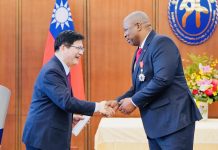Africa-Press – Eswatini. The U.S. and Africa are strengthening ties in renewable energy to address shared goals: boosting investments, improving energy access, and supporting economic growth. Africa’s abundant solar, wind, and mineral resources offer massive potential, while U.S. companies bring expertise and funding. Programs like Power Africa have already mobilized $80 billion, adding 14.3 GW of electricity across the continent. However, challenges like financing gaps, regulatory differences, and geopolitical competition (e.g., China and the EU) remain.
Key Takeaways:
Mutual Benefits: U.S. firms gain market access and critical minerals; Africa modernizes energy systems.
Program Success: Initiatives like Power Africa show how policy coordination drives results.
Challenges: Regulatory fragmentation and inconsistent funding hinder progress.
Opportunities: Standardized policies, technology sharing, and transparent partnerships can strengthen collaboration.
Africa’s energy sector is growing fast, but consistent U.S. engagement is crucial to compete globally and meet shared goals.Key U.S.-Africa Renewable Energy Programs
The United States has introduced several initiatives to deepen renewable energy collaboration with Africa, opening doors for investment, technology sharing, and economic development. These programs highlight how strategic partnerships can tackle energy challenges while advancing U.S. business interests and supporting development across the continent. They turn policy coordination into tangible outcomes, such as increased investments and strengthened energy infrastructure.
Major Partnerships and Programs
One of the cornerstone initiatives is Power Africa, launched in 2013. With $7 billion in U.S. funding, this program has mobilized over $80 billion in commitments, achieving an impressive 11-to-1 leverage ratio and engaging more than 100 U.S. companies.
The African Green Industrialization Initiative is another significant effort. This program focuses on expanding renewable energy technologies and green manufacturing, aiming to position Africa as a leader in the global energy transition. It promotes clean energy adoption and supports industrial growth on the continent.
U.S. companies play a vital role in these efforts, offering expertise in areas like gas turbines, microgrids, and modular energy systems, which are essential for technology transfer and market expansion.
Additionally, these programs support the development of critical minerals, tapping into Africa’s vast reserves of lithium, cobalt, and rare earth elements to strengthen global supply chains.
In response, African governments have implemented regulatory reforms to attract U.S. investments. For instance, Nigeria’s Petroleum Industry Act and the establishment of investment-friendly sovereign wealth funds demonstrate a commitment to creating a conducive environment for foreign capital.
These initiatives showcase how aligned U.S.-Africa policies can promote both economic stability and sustainable growth.
Results and Outcomes
The impact of these partnerships is significant. For example, Power Africa has added 14.3 GW of electricity capacity, improving energy access and enhancing sectors like education, healthcare, and local businesses. The program has also facilitated deals worth over $26.4 billion. Its financial efficiency stands out, as the initial $7 billion U.S. government investment mobilized $80 billion in commitments.Beyond the numbers, these initiatives have bolstered U.S. geopolitical influence in Africa’s energy sector, offering a counterbalance to the growing presence of other global players like China. The rising interest in Africa’s energy markets is evident in events like African Energy Week, which has seen record participation from renewable energy companies.
For African countries, these programs have delivered measurable progress toward energy independence and economic diversification. By utilizing their renewable energy resources and critical mineral reserves, nations are attracting investments, creating jobs, and building modern energy infrastructure that aligns with broader development goals.
While these successes are noteworthy, they also set the stage for addressing remaining regulatory and market challenges.
Challenges and Opportunities in Policy Alignment
Efforts to coordinate U.S.-Africa renewable energy policies face a range of hurdles, including financial, regulatory, and political challenges. While these obstacles slow progress, they also highlight areas where policy improvements can make a real difference.
Regulatory Barriers
One major issue is financing gaps. As Western institutions step back from funding fossil fuels, a critical void in renewable energy financing has emerged. This gap has been partially filled by investors from countries like China and Saudi Arabia, but it leaves U.S. companies with fewer opportunities to contribute to Africa’s energy transition. Without accessible funding, large-scale renewable projects struggle to get off the ground, making it harder to align policies effectively across borders.
Policy fragmentation is another significant challenge. African nations often have diverse and inconsistent regulations, which complicate cross-border renewable energy projects and drive up costs. For instance, differing standards for grid interconnection and renewable energy incentives make it harder for U.S. firms to operate efficiently across multiple African markets.
Adding to these difficulties are political dynamics. Many African leaders are increasingly skeptical of aid programs tied to strict conditions, given past experiences with international financial institutions. Instead, they prefer investment-based partnerships that respect their energy sovereignty and focus on shared economic benefits.
These regulatory and political barriers underscore the need for targeted strategies to create a more unified and effective policy landscape.
Opportunities for Alignment
Despite these challenges, there are clear opportunities to improve policy alignment and foster collaboration.
Regulatory standardization could simplify project development and attract more investment. Aligning technical standards for renewable energy systems, grid integration, and environmental compliance would make cross-border projects more feasible and allow U.S. companies to navigate African markets with greater ease. Regional platforms like the Africa Climate Summit offer valuable opportunities to advance these standardization efforts.
Technology transfer is another promising avenue. By providing access to advanced U.S. technologies – such as green hydrogen, solar systems, and wind power – African countries can adapt these solutions to meet local needs. This not only accelerates renewable energy adoption but also creates a foundation for sustainable partnerships. U.S. firms can supply equipment, expertise, and training, while African nations benefit from capacity building and job creation. However, successful technology transfer requires policies that protect intellectual property and prioritize local skill development.
Improving market access can also foster collaboration. Reducing barriers for U.S. firms – through streamlined regulations, less bureaucracy, and fiscal incentives – can accelerate renewable energy development across Africa. These steps create a win-win scenario: U.S. companies gain new markets, and African nations advance their energy goals.The key to unlocking these opportunities lies in fostering partnerships built on equity and transparency. Investments should be framed as mutual growth opportunities rather than one-sided aid. U.S. policymakers who respect African energy sovereignty and emphasize shared benefits are more likely to build the trust needed for effective policy alignment.
Impact on Trade, Investment, and Supply Chains
When U.S. and African policies align, they trigger significant changes in how businesses operate, where investments flow, and how essential resources move between the two regions. This cooperation not only reshapes trade and investment patterns but also strengthens regional partnerships.
Economic and Geopolitical Effects
Take Power Africa as an example. This initiative has mobilized over $80 billion in commitments, involving more than 100 U.S. companies in energy projects across Africa. It’s a clear demonstration of how coordinated policies can create market opportunities that benefit both U.S. businesses and Africa’s energy sector.
Aligned policies also help by improving market access. For instance, Nigeria’s Petroleum Industry Act has streamlined contracting processes and provided a more stable investment environment. This has made African markets more appealing to U.S. investors. By addressing challenges like foreign exchange risks and regulatory uncertainties, these policies have encouraged U.S. financing agencies, such as the Export-Import Bank, to lift restrictions on African energy projects, paving the way for new investment opportunities.
On a geopolitical level, these partnerships strengthen U.S. influence in Africa, especially in the face of growing competition from China and Russia. Strategic collaborations not only foster stability but also position both regions as leaders in the global energy transition. Reforms like the Midstream and Downstream Gas Infrastructure Fund, which offers improved fiscal terms, reduce project bottlenecks and make investments less risky.
Beyond trade and investment, these policies secure access to critical resources needed for renewable energy, further underscoring their importance.
Critical Minerals and Renewable Energy Supply Chains
Africa is rich in essential minerals like lithium, cobalt, and rare earths – key components for batteries, solar panels, and wind turbines. Policy alignment ensures reliable access to these materials while reducing reliance on other suppliers, particularly China. As demand for technologies like lithium-ion batteries and solar panels grows, Africa’s mineral wealth positions it as a crucial partner for diversifying U.S. supply chains through joint ventures and technology-sharing agreements.
When policies promote joint exploration, sustainable mining, and transparent trade agreements, both sides benefit. For U.S. industries, this means a steady supply of critical materials. For Africa, it brings access to advanced technologies and higher environmental standards for resource development. By encouraging technology transfers, U.S. companies can share mining expertise and equipment, boosting local industries while adhering to international sustainability goals.
China’s significant investments in African mining operations highlight the urgency for U.S.-Africa policy alignment. This partnership offers an alternative approach, one focused on transparency, environmental responsibility, and shared economic benefits.Africa’s Green Industrialisation Framework shows the potential for large-scale collaboration. By utilizing Africa’s resources and renewable energy capabilities, this initiative aims to drive climate-friendly industrial growth, attracting $100 billion in new commitments. This opens doors for U.S. companies to engage in supply chain development, technology sharing, and sustainable industrial projects.
However, success hinges on addressing key challenges like currency risks, infrastructure gaps, and regulatory uncertainties. Continued dialogue and capacity-building efforts are essential to creating frameworks that balance local priorities with global standards.
Policy Alignment Analysis: Pros and Cons
U.S.-Africa cooperation in renewable energy holds promise but also comes with significant challenges. Policymakers and investors must carefully weigh these dynamics to navigate the opportunities and risks effectively.
Advantages and Disadvantages of Policy Alignment
The outcomes of existing programs provide valuable insights into what works and what doesn’t. For instance, the Power Africa initiative has demonstrated strong leverage and measurable commercial success. However, recent events highlight the fragility of these efforts. In early 2025, U.S. representatives blocked a $500 million clean energy disbursement to South Africa, illustrating how political tensions can disrupt funding. This void allowed the European Union to step in with approximately €5 billion, giving competitors a chance to expand their influence in African energy markets.
Regulatory hurdles are another major challenge. The differences in legal frameworks, permitting processes, and environmental standards between U.S. and African jurisdictions can lead to significant delays. Additionally, many African leaders have voiced concerns about aid tied to conditions that may not align with their national priorities. These leaders often favor investment models that respect their energy sovereignty.
Geopolitical factors add another layer of complexity. While aligning policies can strengthen U.S. influence in Africa and address global power shifts, it also makes partnerships vulnerable to changes in U.S. political priorities. Shifts in Washington’s administration or foreign policy focus can create uncertainty for African partners about long-term commitments.
On the brighter side, the collaboration fosters technology transfer and innovation. U.S. companies gain access to new markets and critical minerals, while African nations benefit from advanced clean energy technologies and capacity-building initiatives. These partnerships can promote sustainable economic growth that moves beyond traditional aid structures.These factors highlight the intricate balance between the benefits and challenges of policy alignment, particularly when it comes to funding and resource management.
Funding and Resource Challenges
Funding remains one of the most complicated aspects of U.S.-Africa renewable energy partnerships. Programs like Power Africa show how government investments can attract private sector funding, but inconsistent disbursements create uncertainty for investors. This inconsistency opens the door for other global powers to position themselves as more reliable partners.
Africa’s vast reserves of critical minerals, such as lithium, cobalt, and rare earth elements, present both opportunities and challenges. These resources are essential for renewable energy technologies, giving African nations significant leverage in negotiations. However, ensuring that resource extraction benefits local communities while adhering to international environmental standards requires careful coordination and oversight.
Toward Mutual Investment
Successful partnerships are increasingly being framed as mutual investments rather than traditional aid. African leaders are pushing for agreements that prioritize local capacity-building and respect national sovereignty. For U.S. policymakers, this means focusing on shared growth and transparent collaboration.
Ultimately, the success of U.S.-Africa renewable energy policies depends on political stability and consistent implementation on both sides. Diversified funding sources and long-term commitments that withstand political changes will be essential for building resilient partnerships.
Conclusion: Advancing U.S.-Africa Renewable Energy Collaboration
The partnership between the U.S. and Africa in renewable energy has the potential to bring economic and environmental benefits to both regions. Take Power Africa as an example: with over $80 billion mobilized and significant energy capacity added, it shows how coordinated policies can deliver tangible results. This success challenges traditional models, advocating for partnerships built on mutual benefit and market-driven strategies.
To succeed, these collaborations must prioritize investments that respect Africa’s energy sovereignty and focus on shared prosperity. African leaders have repeatedly stressed the importance of being treated as equal partners rather than aid recipients. This approach not only strengthens relationships but also ensures more durable and impactful outcomes.
Africa’s wealth of resources – like lithium, cobalt, and rare earth elements – plays a critical role in diversifying U.S. supply chains. These materials are essential for clean energy technologies and reducing dependency on single-source suppliers, making the collaboration an opportunity for mutual gain.
At the same time, challenges such as regulatory hurdles, inconsistent policies, and competition from global investors emphasize the need for partnerships that are stable, transparent, and resilient to political and market changes.
Africa’s renewable energy market is rapidly expanding, offering vast untapped potential. For the U.S., staying actively involved in this sector is essential – not just for economic opportunities but also for maintaining geopolitical influence. With countries like China, Saudi Arabia, and members of the EU increasing their investments in Africa’s energy infrastructure, the stakes are higher than ever.
Platforms like Tech In Africa play a crucial role in connecting U.S. and African stakeholders by sharing vital renewable energy developments. By building on proven successes, the U.S. and Africa can accelerate the continent’s energy transition while bolstering America’s leadership in the global clean energy economy.FAQs
What challenges impact U.S.-Africa renewable energy partnerships, and how can they be addressed?
Efforts to develop renewable energy partnerships between the U.S. and Africa face a number of hurdles. Differences in policy frameworks, inadequate infrastructure, and financing shortfalls are some of the main barriers. These challenges complicate the process of aligning objectives and rolling out large-scale renewable energy initiatives.
Addressing these issues requires a multi-pronged approach. Aligning policies through bilateral agreements and establishing shared standards can create a more cohesive foundation for collaboration. At the same time, boosting investments in infrastructure and ensuring access to affordable financing are crucial steps toward closing existing gaps. For these partnerships to thrive, cooperation among governments, private enterprises, and local communities is essential. Together, they can work toward energy solutions that are both sustainable and mutually beneficial.
How does the Power Africa initiative promote economic growth and improve energy access for both U.S. businesses and African nations?
The Power Africa initiative is a dynamic effort that connects U.S. companies with African nations to spark economic growth and improve energy access. For American businesses, it opens doors to invest in and export renewable energy technologies, equipment, and expertise. This not only boosts trade but also encourages new ideas and solutions in the energy sector.
On the flip side, African countries benefit from the development of reliable energy infrastructure and expanded electricity access. By attracting foreign investment, Power Africa strengthens local economies and helps create a foundation for long-term growth. This partnership doesn’t just address the energy gap – it aligns with broader goals of economic progress and environmental responsibility.
How do Africa’s critical minerals contribute to the global renewable energy supply chain, and how can U.S.-Africa policy alignment strengthen this collaboration?
Africa plays a crucial role in supplying critical minerals such as cobalt, lithium, and rare earth elements. These materials are essential components in renewable energy technologies like batteries, solar panels, and wind turbines, making them key to the global shift toward clean energy.
By aligning renewable energy policies between the U.S. and African nations, both sides stand to benefit. Streamlined trade agreements, investments in sustainable mining practices, and shared technology can strengthen this partnership. Such efforts not only help secure a reliable supply chain but also drive economic growth across African countries while advancing global renewable energy goals.
For More News And Analysis About Eswatini Follow Africa-Press







